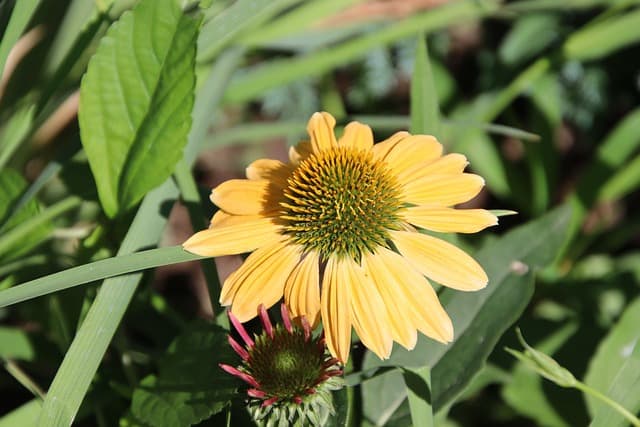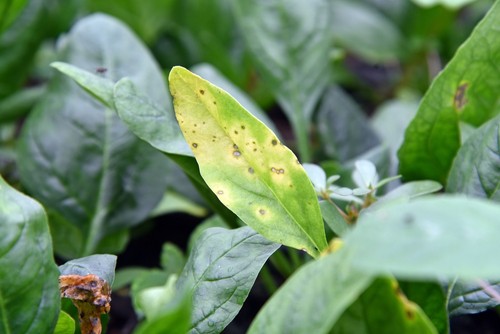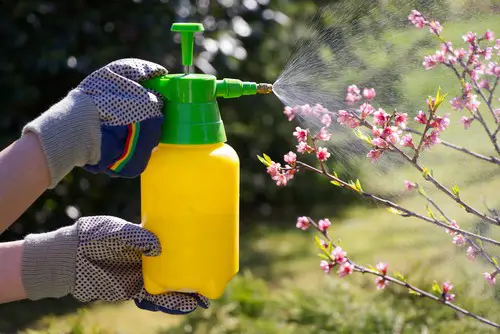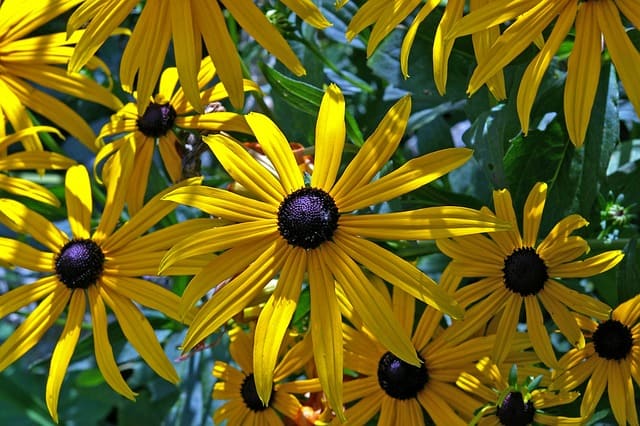Black spots on coneflower leaves can be a frustrating sight for gardeners who have put effort into growing these beautiful plants. These spots can be a sign of disease or pest infestation, or they can be caused by environmental factors. Identifying the cause of black spots is crucial in determining the appropriate treatment and prevention methods.
Common diseases and pests that can cause black spots on coneflower leaves include anthracnose, bacterial leaf spot, and powdery mildew. These conditions can weaken the plant and cause further damage if left untreated.
Environmental factors such as overwatering, poor drainage, and excessive humidity can also contribute to the development of black spots on coneflower leaves.
Preventing and treating black spots on coneflower leaves involves proper plant care and maintenance. This includes providing adequate sunlight and water, improving soil drainage, and removing infected leaves and debris.
Fungicides and other treatments may also be necessary in severe cases. By taking the necessary steps to prevent and treat black spots, gardeners can enjoy healthy and vibrant coneflowers in their gardens.
Key Takeaways
- Identifying the cause of black spots on coneflower leaves is crucial in determining the appropriate treatment and prevention methods.
- Common diseases and pests, as well as environmental factors, can contribute to the development of black spots on coneflower leaves.
- Proper plant care and maintenance, including adequate sunlight and water, soil drainage improvement, and removal of infected leaves and debris can help prevent and treat black spots on coneflower leaves.
Check out these other popular posts:
Identifying Black Spots on Coneflower Leaves

Coneflowers are hardy plants that are relatively easy to grow, but they are not immune to diseases and pests. One of the most common problems that gardeners face when growing coneflowers is the appearance of black spots on the leaves.
These spots can be caused by a number of different factors, including fungal and bacterial infections, as well as environmental stress.
The most common causes of black spots on coneflower leaves are Alternaria leaf spot and bacterial leaf spot. Alternaria leaf spot is caused by the fungus Alternaria echinata, and it can cause small, dark brown to black leaf spots that become oblong and develop lighter-colored centers as they enlarge.
Bacterial leaf spot is caused by the bacterium Pseudomonas syringae, and it can cause water-soaked, black spots on the leaves that may be surrounded by a yellow halo.
Other diseases that can infect coneflowers and cause black spots on the leaves include botrytis leaf spot, stem spot, cercospora leaf spot, and septoria leaf spot. These diseases are caused by different fungi and can cause different symptoms, but they all result in black spots on the leaves.
In addition to diseases, environmental stress can also cause black spots on coneflower leaves. For example, if the plant is not getting enough water, the leaves may develop black spots and become dry and brittle. Similarly, if the plant is exposed to too much heat or direct sunlight, the leaves may develop black spots and become scorched.
To identify black spots on coneflower leaves, look for small, dark brown to black spots on the leaves that may be oblong or have lighter-colored centers. The spots may be surrounded by a yellow halo, and they may merge and cause the entire leaf to die.
If you suspect that your coneflowers have a disease, it is important to take action quickly to prevent the disease from spreading to other plants in your garden.
Common Diseases and Pests
Coneflowers are usually hardy plants, but they can suffer from various diseases and pests. Here are some of the most common ones:
1. Fungal Diseases

Fungal diseases are one of the most common problems that affect coneflowers. The most common fungal diseases that affect coneflowers are powdery mildew, alternaria leaf spot, and stem rot.
Powdery mildew is a fungal disease that causes a white, powdery coating on the leaves of the plant. Alternaria leaf spot is another fungal disease that causes dark, sunken spots on the leaves of the plant. Stem rot is a fungal disease that causes the stem of the plant to rot, which can lead to the death of the plant.
2. Bacterial Diseases
Bacterial diseases are less common than fungal diseases but can still affect coneflowers. The most common bacterial disease that affects coneflowers is leaf spot. Leaf spot is a bacterial disease that causes brown spots on the leaves of the plant. The disease can spread quickly and cause the leaves to drop prematurely.
3. Common Pests
Coneflowers can also be affected by various pests. The most common pests that affect coneflowers are aphids, leafhoppers, eriophyid mites, Japanese beetles, and deer. Aphids are small, soft-bodied insects that suck the sap from the plant. Leafhoppers are small, wedge-shaped insects that feed on the sap of the plant.
Eriophyid mites are tiny mites that feed on the leaves of the plant. Japanese beetles are a type of beetle that feeds on the leaves and flowers of the plant. Deer can also be a problem for coneflowers, as they will eat the leaves and flowers of the plant.
It is important to identify and treat any diseases or pest problems as soon as possible to prevent them from spreading to other plants. Fungal diseases can be treated with fungicides, while bacterial diseases can be treated with antibiotics.
Pests can be controlled with insecticides or by using natural methods such as introducing beneficial insects to the garden.
Environmental Factors Contributing to Black Spots
Coneflowers are popular perennials that are known for their hardiness and easy maintenance. However, they are not immune to certain environmental factors that can cause black spots on their leaves. Here are some of the most common environmental factors that can contribute to the development of black spots on coneflower leaves.
1. Watering Practices
Coneflowers prefer well-draining soil and do not like to be waterlogged. Overwatering can lead to root rot, which can cause black spots on the leaves.
On the other hand, underwatering can lead to drought stress, which can also cause black spots. It is important to strike a balance between the two and water the plants only when the soil is dry to the touch.
2. Soil and pH Factors

Coneflowers prefer slightly acidic to neutral soil with a pH between 6.0 and 7.0. If the soil is too alkaline, the plants may develop nutrient deficiencies, which can cause black spots on the leaves. It is important to test the soil pH and amend it if necessary to ensure optimal growing conditions for the plants.
3. Heat and Drought Conditions
Coneflowers are native to the prairies of North America and are adapted to hot and dry conditions. However, prolonged periods of heat and drought can stress the plants, which can cause black spots on the leaves. It is important to provide the plants with adequate water during hot and dry spells to prevent stress and the development of black spots.
Prevention and Treatment of Black Spots
Coneflowers are beautiful, hardy plants that are easy to grow. However, they are susceptible to black spots caused by fungal infections. If left unchecked, these black spots can spread, causing the leaves to yellow and eventually die. Fortunately, there are several steps that gardeners can take to prevent and treat black spots on coneflower leaves.
Proper Watering and Fertilizing
One of the most important steps in preventing black spots on coneflower leaves is to ensure that they are properly watered and fertilized. Coneflowers prefer well-drained soil and should not be over-watered. Over-watering can lead to standing water around the base of the plant, which can create a moist environment that is conducive to fungal growth.
It is recommended to water coneflowers deeply once a week, rather than giving them frequent shallow waterings. Additionally, coneflowers benefit from a light application of fertilizer in the spring and again in mid-summer.
Use of Fungicides and Pesticides

If black spots appear on coneflower leaves, gardeners can use fungicides and pesticides to treat the infection. There are several garden fungicides available that are effective at treating fungal infections, including copper fungicide and neem oil.
Insecticidal soap can also be used to control pests that may be contributing to the spread of the infection. It is important to read and follow the instructions on the label carefully when using any fungicides or pesticides.
Pruning and Air Circulation
Another important step in preventing and treating black spots on coneflower leaves is to ensure that the plants have adequate air circulation. This can be achieved by pruning back any nearby plants or foliage that may be blocking air flow around the coneflowers.
Additionally, dead or diseased leaves should be removed promptly to prevent the spread of infection. It is also important to mulch around the base of the plant to help retain moisture, but be sure to keep the mulch away from the stems of the plant to prevent fungal growth.
Coneflower Care and Maintenance
Planting and Soil Preparation
Coneflowers (Echinacea purpurea) are hardy perennials that are drought-tolerant and easy to care for. They grow well in USDA zones 3 to 9 and prefer well-drained soil with a pH between 6.0 and 7.0. When planting, choose a spot that receives full sun or partial shade.
Before planting, it is important to prepare the soil properly. Loosen the soil to a depth of 12 inches and mix in compost or aged manure to improve drainage and add nutrients. It is also a good idea to add a slow-release fertilizer to the soil to provide extra nutrients for the plant.
Seasonal Care and Maintenance

Once established, coneflowers require minimal care. They do not require regular watering, but during periods of drought, it is important to water them deeply once a week. Deadheading the spent flowers will encourage more blooms and prevent self-seeding.
In the fall, cut back the stems to the ground after the first frost. This will help prevent the plant from becoming too woody and encourage new growth in the spring.
Dealing with Wildlife
Coneflowers are generally not bothered by pests or diseases, but they can attract rabbits and deer. To prevent damage from these animals, it is important to plant coneflowers in clumps rather than single plants. This will make it harder for animals to reach all of the plants.
If rabbits or deer are still a problem, consider using a repellent spray or planting companion plants that these animals do not like.
Frequently Asked Questions
How do you treat black spots on coneflower leaves?
Black spots on coneflower leaves are usually caused by fungal infections, such as anthracnose or septoria leaf spot. To treat these infections, you can use a fungicide that is labeled for use on coneflowers. Be sure to follow the instructions on the label carefully, and apply the fungicide according to the recommended schedule.
How do you treat coneflower fungus?
To treat coneflower fungus, you can use a fungicide that is labeled for use on coneflowers. Be sure to follow the instructions on the label carefully, and apply the fungicide according to the recommended schedule.
You can also help prevent fungal infections by providing good air circulation around your coneflowers, avoiding overhead watering, and removing any infected leaves or plant debris from the area.
What causes cone flowers to turn black?
Coneflowers can turn black for several reasons, including fungal infections, bacterial infections, stem rot, and poor growing conditions. Fungal infections are the most common cause of black spots on coneflower leaves, and can be treated with a fungicide.
Bacterial infections can also cause black spots, and may require a different treatment. Stem rot is caused by wet conditions and can be prevented by providing good drainage around your coneflowers. Poor growing conditions, such as lack of sunlight or nutrients, can also cause coneflowers to turn black.
How do you get rid of Eriophyid mites on coneflowers?
Eriophyid mites are tiny pests that can infest coneflowers and cause distorted growth and discoloration. To get rid of these mites, you can use a miticide that is labeled for use on coneflowers.
Be sure to follow the instructions on the label carefully, and apply the miticide according to the recommended schedule. You can also help prevent Eriophyid mites by providing good air circulation around your coneflowers and avoiding overhead watering.
What is eating my echinacea leaves?
Several pests can eat echinacea leaves, including slugs, snails, aphids, and Japanese beetles. To identify the pest that is eating your echinacea leaves, you can inspect the leaves and look for signs of damage or the presence of the pest.
Once you have identified the pest, you can use the appropriate treatment to get rid of it. For example, you can use slug bait to control slugs and snails, or insecticidal soap to control aphids.
How to get rid of coneflower mites?
Coneflower mites are tiny pests that can infest coneflowers and cause distorted growth and discoloration. To get rid of these mites, you can use a miticide that is labeled for use on coneflowers.
Be sure to follow the instructions on the label carefully, and apply the miticide according to the recommended schedule. You can also help prevent coneflower mites by providing good air circulation around your coneflowers and avoiding overhead watering.

Hey, I’m Lisa and I’ve been an avid gardener for over 30 years. I love writing, talking and living in the garden! Feel free to connect with me on my socials below


